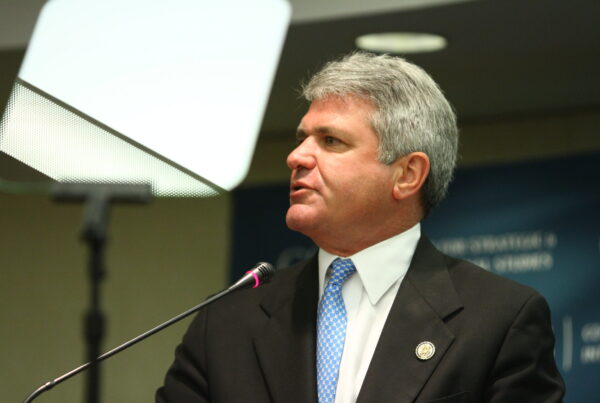Hydrogen-based energy production is the latest big-ticket project to come out of the Biden administration’s Bipartisan Infrastructure Law – and a big portion of the initiative’s $7 billion funding stream is headed to the Texas Gulf Coast.
The HyVelocity Hub is one of seven H2 hubs being built across the country, and it’s a collaboration among seven energy producers that will be built in the Houston region. HyVelocity says the hub will accelerate the development of clean energy and bring jobs to the area.
Brian Korgel, director of the Energy institute at UT Austin and the lead academic partner for HyVelocity, says new technology is allowing much cleaner methods of producing hydrogen than have been possible in the past – an important goal of the project.
Listen to the interview above or read the transcript below.
This transcript has been edited lightly for clarity:
Texas Standard: What exactly is a hydrogen hub?
Brian Korgel: A hydrogen hub is a collection of facilities that are basically going forward to advance both production of clean hydrogen and lower the price of clean hydrogen, as well as create a market for hydrogen. And focused on a particular region.
When you say clean hydrogen, what do you mean? It sounds like you’re hedging hydrogen on its own.
So hydrogen is used for a variety of things right now, especially making chemicals. And so the goal is to be able to produce hydrogen without producing carbon dioxide.
How clean is hydrogen, by the way? And how do you do this without carbon? Where’s the carbon input?
The way hydrogen is typically made now is from natural gas, from CH4. So you convert that into hydrogen and as a byproduct, you make CO2. And right now you get about 11 to 12 kilograms of CO2 per kilogram of hydrogen produced.
And clean hydrogen in the infrastructure bill was defined as two kilograms of CO2 per kilogram of hydrogen. So that’s the kind of clean hydrogen standard people are going by.
» GET MORE NEWS FROM AROUND THE STATE: Sign up for Texas Standard’s weekly newsletters
People have been asking, is hydrogen actually sustainable? And the answer you’ll hear coming from The Guardian newspaper, ‘yes, but in a limited way, given that it takes more energy to produce, store and transport hydrogen than it provides when converted into useful energy.’
What do you say to that? And are there not some critics, especially when it comes to transport of hydrogen? And of course, it’s highly explosive.
There are definitely critics of hydrogen. But if you think about, for example, the industrial sector: So about 30% of our greenhouse gas emissions come from the industrial sectors, like steel making, cement, chemicals. We refer to that as a “hard to abate” sector.
So if you’re trying to reduce greenhouse gas emissions, one of the tools you really need is hydrogen. When you burn hydrogen, you make H2O – you make water – there is an energy input to make the hydrogen, but the emissions are much lower at the end use.
With the establishment of a hydrogen hub, is this basically a collaborative partnership, or are we talking about the construction of a physical structure along the way?
It’s a bit of both. So the funding from the Department of Energy goes towards actually putting steel in the ground, so building facilities. So there are projects that are going to go in the region, but those projects then are connected conceptually at least. And so there’s collaboration between the groups making the hydrogen as well as generating the end use or the market for it.
Well, what’s the market for it right now? Of course, you have the internal combustion engine. There’s been a lot of talk about electricity – solar and wind-generated electricity. Where does hydrogen come into play?
A lot of people will think about hydrogen as maybe a replacement for gasoline – so hydrogen fuel cell cars, things like that.
But hydrogen is also used to make chemicals. So you’ll often have to add hydrogen to some carbon source. So hydrogen has a market right now. It’s just that what we’re trying to do is reduce the cost to make hydrogen that has much fewer emissions, and that’s where the hub comes in.
How far are we from actually using clean hydrogen, as you’re putting it, as a stable, useful energy resource in Texas?
I think we’re pretty close. I mean, Texas is a pretty exciting place for the hub, because right now, Texas has one of the largest hydrogen economies at the moment for the U.S., the chemical production, the ammonia, that sort of thing.
And the technology is coming on board, which really involves kind of two ways of making hydrogen: It can generate hydrogen from natural gas, capture the CO2, and then store it. Or you can use solar, wind, renewable power to take water and split water into hydrogen. That’s electrolytic hydrogen.
So there’s two technologies becoming cost competitive. And I think this hub funding is going to be the catalyst to start to scale the technologies and make it cost-effective.













